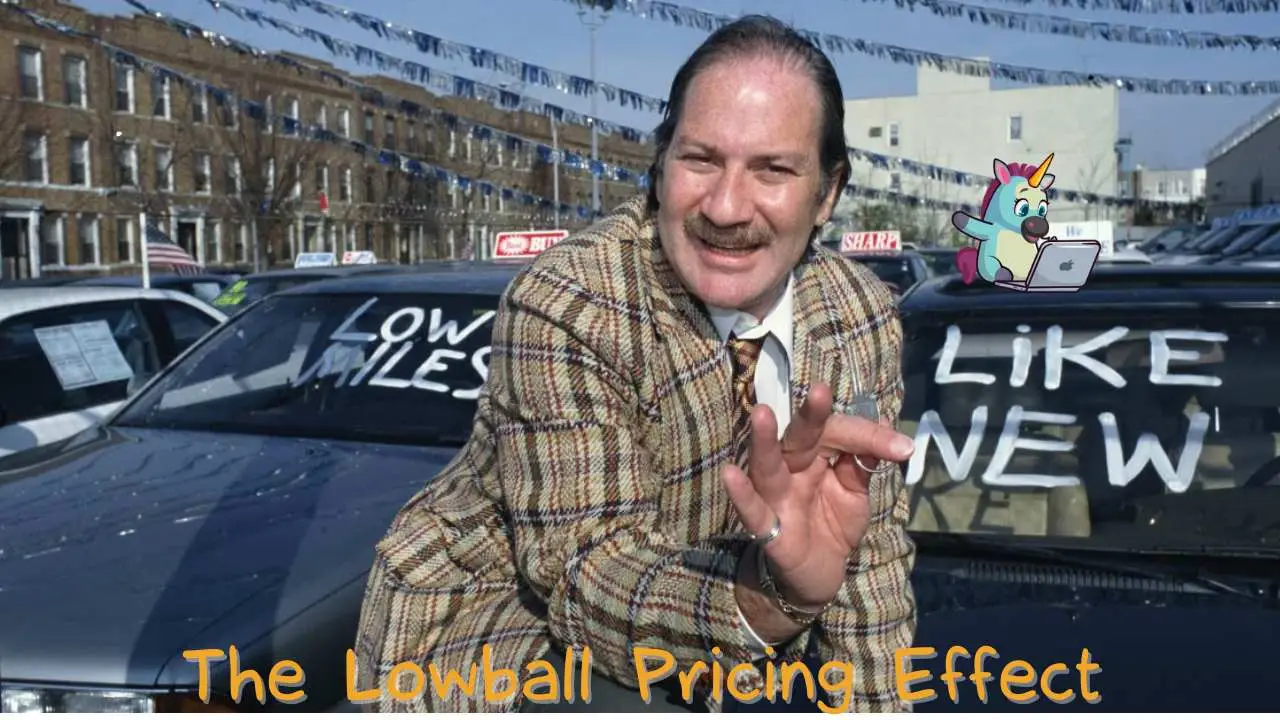
Picture this scenario:
You’re shopping for a new car, and you spot a sleek sedan with a price tag of $20,000.
You don’t believe you will take this car for only $20.000.
And suddenly.
The salesperson approaches you and says, “I have bad news! The price is $23,000. There was a mix up with the price tag.“
Suddenly, the car seems like a not-so-bad deal, and you’re tempted to sign on the dotted line.
But wait a minute…
Was the original price ever realistic, or was it just a clever anchoring tactic?
Enter the Lowball Pricing Effect.
This psychological principle suggests that by initially presenting a low price (the “lowball“), businesses can influence customers’ perceptions of value and make subsequent higher prices seem more reasonable.
It’s like our brains think, “If the first price was so low, then anything higher must be a fair deal!“
🧠 The Psychology of the Lowball

So, what’s the mental magic behind the Lowball Pricing Effect?
It all boils down to a cognitive quirk called anchoring.
When we encounter a price, our brains focus on that initial number as a reference point (the “anchor“) for evaluating future prices.
If the first price is surprisingly low, it sets a lower anchor, making subsequent prices seem more palatable.
The Lowball Pricing Effect exploits this psychological tendency by strategically presenting a low initial price to shape customers’ perceptions of value.
By starting with a tempting offer, businesses can make their actual prices seem like a bargain, even if they’re higher than the initial lowball.
⚖️ The Good, the Bad, and the Lowball

While the Lowball Pricing Effect can be a powerful tool for boosting sales and perceived value, it’s not without its drawbacks:
On the positive side, a well-executed lowball pricing strategy can:
– Attract customers’ attention and generate interest in a product or service
– Create a sense of urgency and scarcity, encouraging customers to act quickly
– Make the actual price seem more reasonable and justified in comparison
However, there are also potential downsides to consider:
– If the lowball price is too far from the actual price, customers may feel deceived or manipulated
– Overusing lowball tactics can erode trust and damage a brand’s reputation for transparency
– Customers may become conditioned to expect lowball prices, making it harder to sell at regular prices
🚨 The Effects of Lowballing Your SaaS
In the world of SaaS, lowballing your prices can have severe long-term consequences:
Low Perceived Value: Price often acts as a signal of quality in SaaS. A low price point can subconsciously lead customers to believe your product offers less value than its competitors.
Erodes Profit Margins: With ongoing development, maintenance, and support costs, pricing your SaaS too low makes it difficult to generate sufficient profit to reinvest in growth and product improvements.
Attracts the Wrong Customers: Low prices tend to attract customers who focus solely on getting the cheapest deal rather than those who value your product’s specific features and benefits. These customers are likelier to churn quickly if a competitor offers an even lower price.
Hinders Long-Term Growth: Lowball pricing makes it challenging to scale your business. Without sufficient profit margins, you can’t invest in marketing, sales, and development activities that fuel growth, keeping you stuck in a cycle of low revenue and limited market reach.
To effectively leverage the Lowball Pricing Effect, SaaS businesses must carefully consider the potential drawbacks and find a balance between attractive initial offers and sustainable, value-based pricing.
Lowball Pricing Hall of Fame GOATs

Check out these brands that have mastered the art of anchoring expectations and influencing perceptions:
Groupon Lowball Pricing
– Groupon, the popular daily deals platform, often features deeply discounted offers to attract customers. By presenting these lowball prices alongside the regular retail prices, Groupon creates a sense of urgency and value, encouraging users to snap up the deals before they expire.
GoDaddy Lowball Pricing
– GoDaddy, the domain registrar, and web hosting company, frequently advertises low introductory rates for its services. These lowball prices serve as anchors, making the regular prices seem more reasonable in comparison and encouraging customers to sign up for longer-term contracts.
Furniture Stores Lowball Pricing
– Many furniture stores use lowball pricing tactics to drive sales. By initially presenting a low price and then gradually revealing additional costs (like delivery fees or taxes), these retailers can make the final price seem more palatable to customers who are already anchored to the initial lowball offer.
By studying these examples, understanding the psychology behind the Lowball Pricing Effect, and considering the potential pitfalls, you can develop a balanced pricing strategy that maximizes perceived value while maintaining long-term profitability.
Just remember: in the game of lowball pricing, it’s all about finding the sweet spot between attraction and sustainability!


Leave a Reply